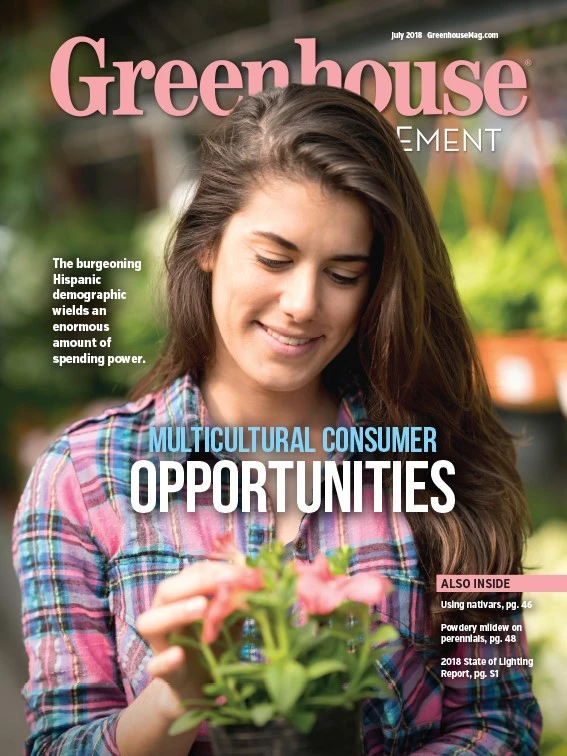
Abbottsford, British Columbia-based Van Belle Nursery uses technology to its advantage, implementing overhead irrigation, as well as drip irrigation when needed, and collecting water from rain, plants and irrigation. In its Colour-Retail Ready Division, Pablo Costa also controls the operation’s LED lights with sensors.
Costa, operations manager for the nursery’s Colour-Retail Ready Division, grows hydrangeas under LED lights in one, one-acre zone — out of 10 acres of total greenhouse space that is covered with double poly. He also performs trials with the LEDs on various annuals, perennials and succulents. “Definitely, in our location, we need supplemental light to have crops for early spring,” he says. “It’s essential to produce that crop and have early flowering.” If Van Belle Nursery didn’t use LEDs, Costa says, it could lose that early spring crop.
From January through around May, Costa runs the Philips Lighting-brand LEDs during the early morning and at night. This is to extend the amount of light the plants receive throughout a given day — or the daily light integral (DLI) — which, in the dead of winter, is sometimes only about eight hours of natural sun. This equals about two moles of light per day in January, Costa says, but hydrangeas need at least 12 moles per day. “[We use LEDs for] basically the DLI light program and also the hours,” Costa says. “I like to have at least 12 hours of light continuously, plus the light intensity.”
How LEDs help Van Belle Nursery
Van Belle Nursery needed supplemental lighting to achieve optimal development for early spring, and it implemented LEDs three years ago, in part, because of energy costs, Costa says. Although the initial investment is higher for LEDs than for high-pressure sodium (HPS) lights, LEDs are lower maintenance, last longer and do not give off the same amount of heat as HPS lights, Costa says.
Because the light intensity is low in Abbottsford, LED lighting aids in the production of most plants, Costa says. Van Belle Nursery works together with Dr. Abhay Thosar, senior plant specialist at Philips Lighting, to select the best light spectrum for each species of plant, Costa says. “What I noticed that is [by] using these purple lights — some colors, like red on the leaves or red on the flowers — [are] getting more intense,” he says.

In Costa’s experience, LED lighting often speeds up plant development and growth, and the plants develop more than they do under only natural light. He points out that light, along with water and fertilizer, are integral for plant growth. “It’s part of the triangle that the plants need,” he says. “If you have more and you are more under the requirements that the plants need, you are going to have better performance.”
Plants with red hues that Costa grows under LEDs, including many of the hydrangeas and annuals such as coleus, have stronger colors than those that he grows without LEDs, he says. “Also, the green color of the leaves is greener, so at some point, you need less spraying of micronutrients than we usually do, especially for the hydrangeas,” he says. “When you have [plants] under the lights, the color of the leaves is a little bit greener than the other ones, which are paler.”
With the added light, the plants also stretch less and are more compact, Costa says. “At the end, we use less PGRs, and we have the flowering on time,” he says.

Getting into a rhythm with LEDs
“I think we were one of the pioneers using LED lights for ornamental plants,” Costa says. Van Belle Nursery plans to continue performing research on the effects of LEDs on retail-ready plants, he says, and it is exploring the benefits of LEDs in young plant production.
In his three years of experience working with LEDs, Costa says he has become more accustomed to controlling the lights and taking measurements. “You have to look very closely to measure how your light intensity [is] outside, how your light intensity [is] inside — I change the poly on the greenhouse — so it’s continuous learning,” Costa says, adding that he needs to make preventative rather than reactive decisions.
Looking to the future, Costa says he sees Van Belle Nursery continuing to advance through the addition of LEDs. “I think it’s going to help that the price is going down in the investment, because it is a very high investment that you have to [make] right now,” he says. Costa predicts that the prices will probably still go down in the future, resulting in a faster ROI. “Now, it’s taking roughly five years to return the investment,” he says. “If [initial costs are] going to go lower than that, definitely, it’s going to help.”

Explore the July 2018 Issue
Check out more from this issue and find your next story to read.
Latest from Greenhouse Management
- Anthura acquires Bromelia assets from Corn. Bak in Netherlands
- Top 10 stories for National Poinsettia Day
- Langendoen Mechanical hosts open house to showcase new greenhouse build
- Conor Foy joins EHR's national sales team
- Pantone announces its 2026 Color of the Year
- Syngenta granted federal registration for Trefinti nematicide/fungicide in ornamental market
- A legacy of influence
- HILA 2025 video highlights: John Gaydos of Proven Winners





